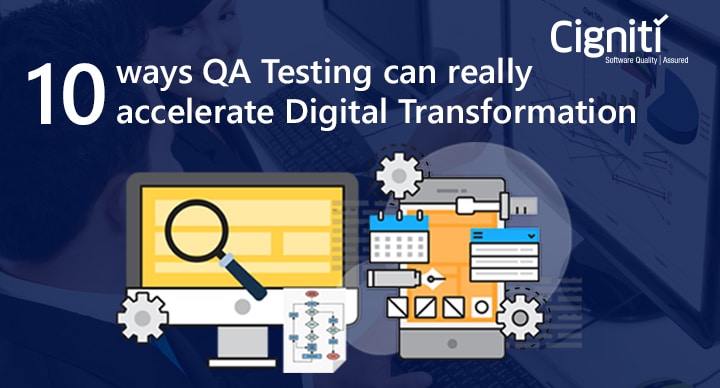Evolution of quality assurance – from an independent function to an inclusive function
For the longest time, Software Quality Assurance teams have operated independently from the software development lifecycle. QA acted as the last gatekeeper for quality parameters, software defects, and bugs before the code was released into the production.
Being an independent function, QA seldom gained the priority and prominence that it deserves at the table. But today, as end users became more demanding, the outlook towards quality assurance has evolved tremendously.
A few years back, QA started to shift to the left in the SDLC – starting earlier to detect defects earlier. From having QA as an independent function, organizations began to integrate it within the SDLC to take care of quality right from the beginning. This shift in the QA practice emerged from the need of achieving both quality and speed in the code releases.
Today, it is not only about achieving quality at speed. Rather, customers now expect both quality AND value at speed. This trend can very much be attributed to the rapid acceleration of digital transformation and the move toward a digital-first world. Consequently, QA needs to move deeper into the software development process. This means a transition to being an inclusive function, which entails greater responsibilities for QA teams than simply finding and reporting defects in the code.
With the increasing adoption of DevOps and Agile practices, maturing digital transformation curves, and introduction of state-of-the-art techniques like Artificial Intelligence and Machine Learning, the role of QA is also expanding to fulfilling organizational quality objectives and inculcating better engineering practices.
Certainly, QA now has a much bigger and more important role to play than ever before. Let us delve further into the scope of this evolution and understand how the picture of software quality assurance is going to look like in the coming future.
Objectives of QA and software testing in an organization
The primary objective of having a formal QA practice would be to deliver the highest quality in the end products at high speed. The implications of this objective are much deeper though.
Being the custodian of quality, QA shoulders the maximum responsibility to detect defects before a code goes live into production. By ensuring maximum defection detection and minimum defect leakage, QA has the onus toward delivering excellent customer experience and end user satisfaction.
As quality, value, and speed become the tri-factor demand of the end users, organizations are focusing their QA functions to establish a standard quality practice across the tiers. This would enable a culture of quality throughout an organization, such that QA function will offer support to uphold the desired quality standards.
Lack of right testing methodologies is one of the main challenges in achieving the right levels of quality amidst the speeding up development cycles. By streamlining QA, organizations can not only fulfill their requirements for quality and value at speed but also fortify their business growth and improve their brand’s overall perception among the customers.
Key trends in software quality assurance
With the evolution of organizational objectives for QA and software testing, some key trends are also emerging in the quality assurance space to meet those objectives.
1. The rising popularity of chaos testing
Instead of following the traditional approach of waiting for the defects to occur, chaos testing takes a proactive way. Through intentional introduction of software failures, the chaos testing method measures the software’s ability to tackle the glitches and evaluate their impact on its availability and durability.
This approach helps organizations to deliver a software solution that is resilient and is prepared to handle minor glitches and outages. The end result is better quality and value for the end users.
Also read: How Chaos Testing helps build and deliver resilient software
2. Exploratory testing gaining momentum
Considering the possibility that the test requirements may miss some critical scenarios and may lead to compromised quality in the end product, exploratory testing is becoming a popular practice.
While organizations try to establish standardized QA practices, going a little gorilla with exploratory testing can help them uncover bugs and high-risk vulnerabilities that can prove fatal in the future. And, as agile and DevOps become a more common practice, exploratory testing allows developers to actively contribute in the defect detection process.
Also read: The what, why, and how of exploratory testing
3. Test Environment Management (TEM) and Test Data Management (TDM)
Test Environment Management (TEM) and Test Data Management (TDM) have traditionally been among the most expensive and challenging aspects of a QA practice. Provisioning and maintenance of the appropriate test environment and the required test data require time, skills, and resources, which organizations often have a scarcity of.
However, the migration toward cloud has driven down the costs for TEM. And, it is expected that organizations will be employing smart technologies like AI and ML for TDM and TEM.
Also read: 5 Ways to Ensure Successful Test Environment Management
To sum up
From being an independent function to an integrated function, to now slowly becoming inclusive to software development, QA has undergone a complete evolution.
Cigniti offers independent quality engineering and a wide range of software testing services and solutions for the next generation enterprises and ISVs across the globe. Our experienced and deep-skilled quality assurance professionals have a hands-on, end-to-end understanding of the challenges faced by enterprises while on the path of digital transformation.
We implement the best possible software testing methodologies and applications, a Testing Center of Excellence, and world-class software testing Labs to deliver on our promise of Quality Engineering, Quality Assurance, and Digital Assurance.
Whether you have desktop, mobile or next-gen-based applications, our software testing specialists work with a focused approach to help you get more out of your testing efforts and improve time to market, and thus, your ROI.
Let’s have a discussion regarding your QA needs and how we can help fulfill them.





Leave a Reply